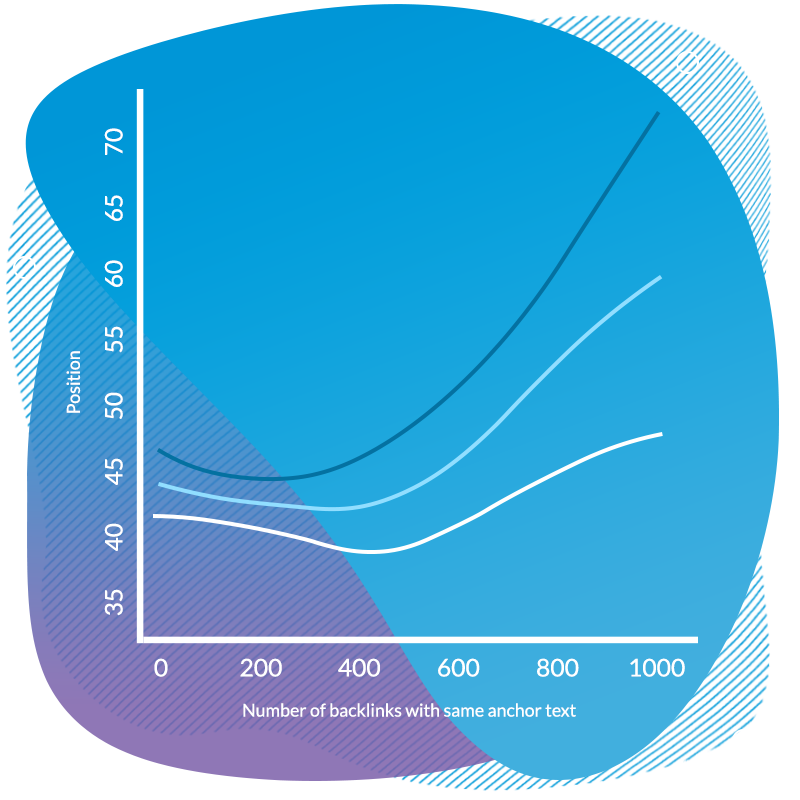Latest From The Sayu Blog



During April 2012 there have been changes in Google's ranking algorithm that has resulted in some sites being “penalized” for unnatural link building. Some sites have had messages from Google to warn them they have found evidence of unnatural linking but others have been affected even though they didn't receive any warning from Google about unnatural link building.
So what factors are Google looking at to determine whether or not a site has an unnatural link profile?

We have been investigating which factors affect the rankings and following the recent Google updates we have become specifically interested in what factors have changed. To determine what has changed we looked at the top 100 positions on google.co.uk for around 100 keywords in the “bed” sector.
For this we analysed around 10,000 pages (and about 1,000,000 backlinks, courtesy of www.majesticseo.com) looking at the change in position before and after the recent Google updates.
The group of keywords covered different types of beds such as '4ft beds', 'cabin beds', 'sofa beds' as well as keywords like 'beds online', 'bed shops', 'beds uk'.
Initial investigations suggested that factors affecting the rankings are...


Page Rank

The index page (even if that isn't the one ranked)

UK Hosted Site

The domain

Keyword in the domain name, title and description tag

Number of anchor texts that contain either the keyword itself or a stemmed version of the keyword

Unique referring domains of backlinks to the page ranked

Number of anchor texts that contain the word 'be'
We haven't looked at other content on the page which may also affect the ranking, nor have we looked at the content of the referring domains and the relevance of that content to the keywords ranked. There are no surprises in the above factors determining how well a page ranks, but we found there has been a change in how important these factors are after the recent updates.

One of the suspected factors for dropped positions for some sites is the overuse of the same anchor text. We looked at the change in position for those pages where the top anchor text accounts for 35% or more of the backlinks and on average those pages have dropped statistically significantly more compared to pages that didn't have such high anchor text concentration.
Figure 1 shows the average position for varying numbers of backlinks with the same anchor text. (As these are just averages from a sample of keywords, we have also indicated by how much the curve could vary.) While the average position improves slightly for sites with up to 200-400 backlinks with the same anchor text, for sites with more backlinks with the same anchor text the position starts to drop significantly.

Figure 1. Average position v number of backlinks with top anchor text (black curve).
Although there is a correlation between position and number of backlinks with the same anchor text, we cannot conclude that a high number of backlinks with the same anchor text is the cause for the drop in position. There could be other factors related to the number of backlinks with the same anchor text that is the actual reason for the drop in position. For example, there is some overlap between the number of backlinks with the same anchor text and the number of backlinks from the same domain. It could be that sites are penalized for using many links from the same domain, which tend to have the same anchor text (especially when sitewide links are used). Around a quarter of sites in our dataset had at least 100 links from the same referring domain with the same anchor text.

The article on Micrositemasters.com suggests that sites with a large percentage of keyword related anchor texts have been affected by the update. Although the data illustrates that penalized sites all had a large percentages of keyword related anchor texts, there were also many non-penalized sites that had backlinks with a large percentage of keyword related anchor texts. It is therefore not necessarily the case that using large percentages of keyword related anchor texts is the cause for the penalties or drop in positions.


There could be another factor that differentiates the penalized and non-penalized sites, which may be related to the high frequency use of keyword related anchor texts. The diversity of the anchor text within these may play a role in whether sites are affected. In our analysis we looked at whether the number of backlinks containing bed or beds in the anchor text have an effect on the ranking. In our initial analysis which used data from March, we found that the number of backlinks with bed related anchor texts had a positive effect on the ranking.

One of the suspected factors for dropped positions for some sites is the overuse of the same anchor text. We looked at the change in position for those pages where the top anchor text accounts for 35% or more of the backlinks and on average those pages have dropped statistically significantly more compared to pages that didn't have such high anchor text concentration.
Figure 1 shows the average position for varying numbers of backlinks with the same anchor text. (As these are just averages from a sample of keywords, we have also indicated by how much the curve could vary.) While the average position improves slightly for sites with up to 200-400 backlinks with the same anchor text, for sites with more backlinks with the same anchor text the position starts to drop significantly.
Figure 2 gives the average position given the number of backlinks with bed(s) related anchor texts for 19 April (black) and 30 April (red). We can see that the position improves as more backlinks with bed(s) related anchor texts are used, but there is only an improvement in the position up to around 300 backlinks. Beyond that, the position begins to deteriorate, even looking at data from 19th April, before the Google update. So Google was possibly already penalizing sites that overused backlinks with keyword related anchor texts. Note that the difference in the curves for 19 and 30 April is not found to be statistically significant, in other words, there is no evidence that there has been a change in Google algorithm with respect to the number of keyword related anchor texts. This doesn't mean there hasn't been a change, but if there has been a change it hasn't had a big (negative) impact on the position, and there is still a positive effect on the position when more backlinks with keyword related anchor texts are used up to around 300 backlinks.

Figure 2. Position given the number of backlinks with bed or beds in the anchor text
An anchor text related factor that has seen a change after the Google updates is the backlinks with anchor texts that contained stemmed versions of the keywords ranked (for example anchor texts containing plurals of singular keywords ranked or the other way around). Our analysis shows that pages with backlinks with an anchor text that is a stemmed version of the keyword, have seen a drop in the position.

Figure 3. Position given the number of backlinks with anchor texts equal to stemmed versions of the keyword ranked
Figure 3 show the average position given the number of backlinks where the anchor text is equal to the stemmed version of the keyword (for example anchor text is beds when keyword is bed or the other way around). The black curve is for 19th April, before the Google updates, and the red curve is for positions on 30th April, after the Google updates. We can see that the position improves as more backlinks go to the page ranked with an anchor text equal to the stemmed version of the keyword ranked. This is true before as well as after the Google update, but the improvement in the position is not as large after the Google update and on average the position is lower on the 30th Aprill. The drop in the position is small when only a few backlinks contain the stemmed anchor text, but pages relying on more backlinks with stemmed anchor text have seen a bigger drop in the position. The difference between 19 and 30 April is statistically significant.
Figure 4 shows the average position given the number of backlinks where the anchor text contains a stemmed version of the keyword. So for the keyword beds these could be backlinks with for example cabin bed, bunk bed or sofa bed as the anchor text. The black curve is for 19th April, and again we can see an improvement in the position when more backlinks are used with anchor texts containing the stemmed keyword, although the improvements in position is not as good compared to backlinks with anchor texts equal to the stemmed keyword. Then looking at data from 30th April, there is no longer a statistically significant improvement in the position, and compared to 19th April, the average position has dropped. The drop in the position is bigger as more backlinks with stemmed anchor texts have been used..

Figure 2. Position given the number of backlinks with bed or beds in the anchor text

So using backlinks with anchor texts with stemmed versions of the keywords has become less effective, and pages relying heavily on those backlinks are likely to have seen a significant drop in position

Not just in the anchor text it is important whether the actual keyword is used or a stemmed version. There have also been changes in the position for domains that have a stemmed version of the keyword in their domain name rather than the actual keyword. Table 1 illustrates the change. While the position for keywords hasn't changed for domains that have the actual keyword in the domain name, for those domains that have a stemmed version of the keyword in the domain name the average position has dropped from 24.5 to 33.7. We have to note that the data in Table 1 is based on data from .co.uk and .com domains. We noticed that some other types of domains (e.g. .net, .org and .biz) have seen a significant drop in positions if there is a site with the same domain name but with a .co.uk or .com extension.

Based on the analysis of positions for bed related keywords, we can say that it is very likely that Google has changed it's algorithm with regard to how it weights backlinks depending on the anchor texts used.
It appears that using a high concentration of anchor texts has had a negative effect and backlinks with anchor texts with stemmed versions of the keywords seem to have become less effective in improving the position.
Domains with bed related keywords in their domain name are likely to have seen a drop in position for keywords that are a stemmed version of their domain name and .biz, .org, .net domains will now struggle to compete with their .co.uk and .com counter parts.
As we have seen in this analysis any bed related anchor texts can help to improve the position, so when building backlinks to your site, make use of a variety of anchor texts related to your keywords.

If you would like us to check over your Microsoft account to see how much you are spending on traffic you might not want, give us a call! We can help you to eliminate that traffic and continuously monitor your account to keep your cost down.
Sayu is a full service digital marketing agency with 20 years of experience in delivering digital marketing campaigns for businesses of all sizes, from startups to global brands. Proud to be recognised by Google as a Premier Partner, being among the top 3% of Google's partners in the UK


